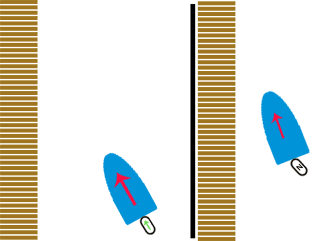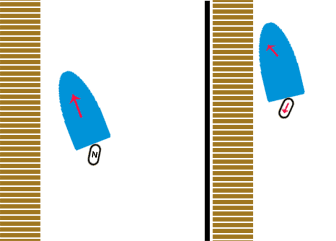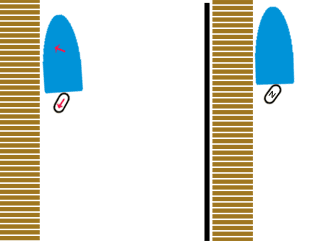In the images below, the red arrow on the boat is a speed vector, indicating the speed and direction of movement of the boat

1. Approach the dock at an angle, then shift into neutral

2. Turn the engine hard over toward the dock, then shift into reverse

3. Shift into neutral, calmly tie up to the dock
Just Follow The Pictures:
One, Two, Three
Bringing a boat smoothly to a stop alongside a dock is a simple procedure that anyone can learn with some practice. I use the same method for docking any boat powered by a single outboard or sterndrive (inboard/outboard) engine. If you have trouble docking your boat, it's a good idea to practice this maneuver a few times in a situation where you don't have passengers or onlookers to make you nervous — but once you master this procedure, you'll be docking like a pro!
It's always fun to watch the looks on the faces of inexperienced boaters when they see this for the first time.
1. Approach the dock at an angle and shift into neutral
In the first picture, the boat is approaching the dock at an angle, going at a speed fast enough to maneuver effectively, with the engine at dead idle in forward. The first step is to put the engine in neutral and turn it away from the dock.
The boat will slow down, and will start to line up with the dock as it comes closer. Your passengers will look at the situation with satisfaction. A smooth approach.
2. Turn the engine hard over toward the dock, then shift into reverse
In the next picture, with the engine still in neutral, turn it hard over toward the dock. The boat continues to slow down, but the bow starts to rotate toward the dock again for a moment.
Your passengers look at you with wide, questioning eyes. Does this idiot know what he is doing? Why does he want to ram the dock with the nose of the boat?
Shift the engine into reverse. The boat is still moving forward, but slows down dramatically, and the stern is "sucked" toward the dock by the reversing engine.
At this point, your passengers will think you are barely in control of the situation, and may try to prematurely reach out and grab the dock to stop the boat. Stop them.
3. Shift into neutral and tie up to the dock
In the third picture, the speed of the boat has dropped to near zero, and it is aligned with the dock. As it comes to a stop, shift the engine into neutral.
The relief on the faces of your passengers will be satisfyingly visible. After they have seen you do it a few times, they will learn that you actually intended to slide sideways to a stop alongside the dock.
Great! But what’s the proper way to BACK IN to a slip? Please advise. We have twin Mercruiser I/O’s on our 31′ Cruisers Yacht.
Captain Arnie,
To back a twin engine boat into a slip, just position the boat in front of the slip and stern-to. If there is a cross wind or current, angle the boat into it slightly, then center the helm. Begin backing in with both engines, and if you get too close on one side, put the opposite engine in neutral briefly. Although you never want to approach a dock any faster than you are willing to hit it, going too slow makes the maneuver more difficult, as wind and current have more opportunity to mess up your alignment with the slip.
This kind of article on docking in a slip both straight in and backing would be great
I am a brand new boater I have had no experience at piloting a boat in years and these articles have been excellent for me to learn the basics and I am very greatful. thanks
Got any tips for jetboats? I have an 18 foot Seadoo and it is a floating brick with the impeller in neutral
Robert, shifting a jetboat into neutral just redirects the thrust straight down. Turning the wheel may or may not be effective, depending on the boat. Reverse redirects the thrust back under the boat. Steering control in reverse is OK, not great, in jet craft. The “usual” wheel inputs for those accustomed to outboard or sterndrive boats is reversed. Turning the wheel to port on a jetboat results in backing to starboard. Practice in a calm place with no wind or current and no obstacles to hit.